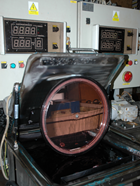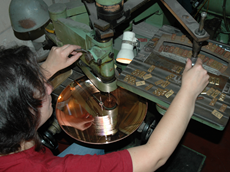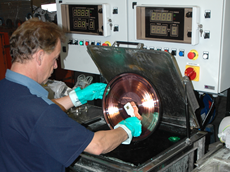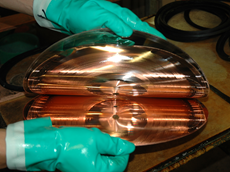Technologie výroby gramofonových desek pomocí “přímého řezání do kovu”, anglicky Direct Metal Mastering neboli DMM, zahrnuje kromě vlastního řezání zvukových drážek do měděné vrstvy, které je detailně popsáno na stránce Mástering, také několik dalších procesů, jejichž správné provedení je důležité pro získání kvalitní lisovací matrice.
Výroba prázdných DMM nosičů
 Výroba prázdných poměděných nosičů je prvním krokem DMM technologie. Na rovný, vyleštěný kotouč z nemagnetické oceli se v galvanické lázni nanese vrstva vysoce čisté mědi o tloušťce minimálně 100 mikrometrů. Vrstva mědi musí mít takové vlastnosti, aby bylo možné do ní následně řezat diamantovým nožem zvukové drážky, tedy nesmí být ani příliš měkká ani příliš tvrdá. GZ zakoupila DMM technologii v roce 1985 přímo od německé firmy Teldec, která ji počátkem 80. let vyvinula a uvedla na trh. Výhodou vlastní výroby poměděných nosičů je zejména možnost kontroly jejich kvality a optimální přizpůsobení kapacitním požadavkům výrobního procesu.
Výroba prázdných poměděných nosičů je prvním krokem DMM technologie. Na rovný, vyleštěný kotouč z nemagnetické oceli se v galvanické lázni nanese vrstva vysoce čisté mědi o tloušťce minimálně 100 mikrometrů. Vrstva mědi musí mít takové vlastnosti, aby bylo možné do ní následně řezat diamantovým nožem zvukové drážky, tedy nesmí být ani příliš měkká ani příliš tvrdá. GZ zakoupila DMM technologii v roce 1985 přímo od německé firmy Teldec, která ji počátkem 80. let vyvinula a uvedla na trh. Výhodou vlastní výroby poměděných nosičů je zejména možnost kontroly jejich kvality a optimální přizpůsobení kapacitním požadavkům výrobního procesu.
Gravírování identifikačních údajů
 Nosič se zvukovým záznamem másteringové studio předá do oddělení galvanoplastiky. Tam se do prostoru mezi výjezdovými drážkami vygravíruje matriční číslo, které je základním identifikačním údajem nejen pro správné přiřazení jednotlivých stran desek k sobě a k etiketám, ale také pro evidenci ve skladu a v databázi. Na přání zákazníka lze vygravírovat i další údaje např. katalogové číslo, název vydavatelství, krátký text apod. Gravírování se tak přenese na lisovací matrici a všechny vylisované desky.
Nosič se zvukovým záznamem másteringové studio předá do oddělení galvanoplastiky. Tam se do prostoru mezi výjezdovými drážkami vygravíruje matriční číslo, které je základním identifikačním údajem nejen pro správné přiřazení jednotlivých stran desek k sobě a k etiketám, ale také pro evidenci ve skladu a v databázi. Na přání zákazníka lze vygravírovat i další údaje např. katalogové číslo, název vydavatelství, krátký text apod. Gravírování se tak přenese na lisovací matrici a všechny vylisované desky.
Výroba matric
 DMM nosič se zvukovým záznamem a provedeným gravírováním se po důkladném odmaštění a opláchnutí demineralizovanou vodou zavěsí jako katoda do galvanoplastické lázně, kterou tvoří roztok niklových solí a dalších přísad. Elektrický proud procházející od niklové anody ke katodě způsobí, že se na měděné vrstvě DMM nosiče postupně vyloučí potřebná vrstva kovového niklu. Oddělením narostlé niklové vrstvy získáme zrcadlový obraz (negativ) záznamu,
DMM nosič se zvukovým záznamem a provedeným gravírováním se po důkladném odmaštění a opláchnutí demineralizovanou vodou zavěsí jako katoda do galvanoplastické lázně, kterou tvoří roztok niklových solí a dalších přísad. Elektrický proud procházející od niklové anody ke katodě způsobí, že se na měděné vrstvě DMM nosiče postupně vyloučí potřebná vrstva kovového niklu. Oddělením narostlé niklové vrstvy získáme zrcadlový obraz (negativ) záznamu,
 tedy neopracovanou lisovací matrici. Z jednoho DMM nosiče je možné získat několik lisovacích matric, a to i opakovaně po několika letech. Po dokončení všech výrobních operací s měděným nosičem se tento opět důkladně opláchne, usuší, zabalí, zavaří do vzduchotěsné fólie a uloží do skladu. K výrobě každé jednotlivé matrice DMM technologii tedy stačí pouze jedno galvanoplastické kopírování, což umožňuje velmi věrnou reprodukci zvukových drážek.
tedy neopracovanou lisovací matrici. Z jednoho DMM nosiče je možné získat několik lisovacích matric, a to i opakovaně po několika letech. Po dokončení všech výrobních operací s měděným nosičem se tento opět důkladně opláchne, usuší, zabalí, zavaří do vzduchotěsné fólie a uloží do skladu. K výrobě každé jednotlivé matrice DMM technologii tedy stačí pouze jedno galvanoplastické kopírování, což umožňuje velmi věrnou reprodukci zvukových drážek.